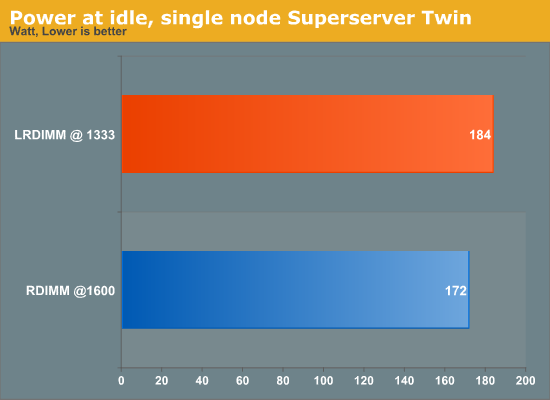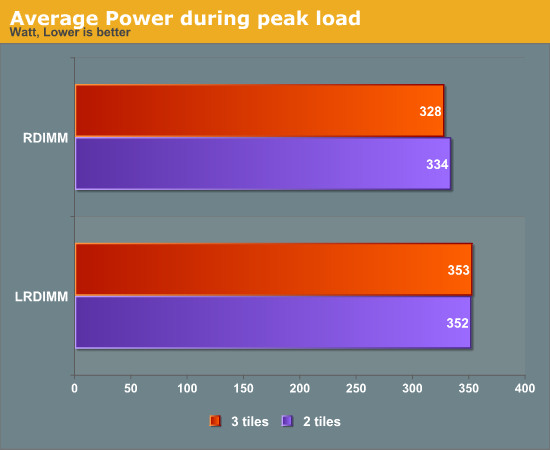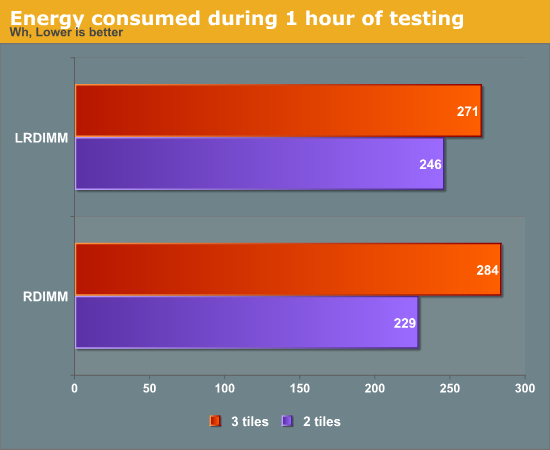LRDIMMs, RDIMMs, and Supermicro's Latest Twin
by Johan De Gelas on August 3, 2012 4:45 AM EST- Posted in
- IT Computing
- Intel
- Samsung
- Xeon
- Cloud Computing
- Supermicro
Energy Efficiency
Next stop is of course power and energy. First we check out idle power. Idle power is measured with one node and one power supply active.

For a system equipped with an LSI SAS 6G and a Mellanox ConnectX-3 FDR Infiniband controller, 168W per node is a very decent power level for our Supermicro 6027TR-D71FRF server. The HP DL380 G7, the most efficient server of the previous generation, needed 158W with 15 4GB DIMMs but with a 460W PSU.
The premium for the iMB buffer is about 1.5W per DIMM, which is a bit higher than expected (1W). Of course we measure at the wall, so some voltage regulation and PSU overhead is added.
As each power line has only a limited amount of amps available in the datacenter, it is good to check power under heavy load.

The LRDIMM equipped server needs 19W more or 2.4W per DIMM. Again, this is a bit higher than expected. To get the complete picture, we measured the total energy consumed during one hour of testing. All configs got the same workload but the LRDIMM equipped servers finished the jobs more quickly.

The result is that the LRDIMM equipped server is consuming less with three tiles, while the 64GB RDIMM consumes less with two tiles. Better performance results in lower power thanks to the advanced core sleep states of the Xeon E5 "Sandy Bridge EP".










26 Comments
View All Comments
koinkoin - Friday, August 3, 2012 - link
For HPC solutions I like the Dell C6220, dense, and with 2 or 4GB of memory per cpu core you get a good configuration in a 2U chassis for 4 servers.But for VMware, servers like the R720 give you more room to play with memory and IO slots.
Not counting that those dense server don’t offer the same level of management and user friendliness.
JohanAnandtech - Friday, August 3, 2012 - link
A few thoughts:1. Do you still need lots of I/O slots now that we can consolidate a lot of gigabit Ethernets in Two 10GBe
2. Management: ok, a typical blade server can offer a bit more, but the typical remote management solutions that Supermicro now offers are not bad at all. We have been using them for several years now.
Can you elaborate what you expect from the management solution that you won't expect to see in a dense server?
alpha754293 - Friday, August 3, 2012 - link
re: network consolidationNetwork consolidation comes at a cost premium. You can still argue that an IB QDR will give you better performance/bandwith, but a switch is $6k and other systems that don't have IB QDR built in, it's about $1k per NIC. Cables are at least $100 a piece.
If you can use it and justify the cost, sure. But GbE is cheap. REALLY REALLY cheap now that it's been in the consumer space for quite some time.
And there aren't too many cases when you might exceed GbE (even the Ansys guys suggest investing in better hardware rather than expensive interconnects). And that says a LOT.
re: management
I've never tried Supermicro's IMPI, but it looks to be pretty decent. Even if that doesn't work, you can also use 3rd party like logmein and that works quite well too! (Although not available for Linux, but there are Linux/UNIX options available out there as well).
Supermicro also has an even higher density version of this server (4x half-width, 1U DP blade node.)
JonBendtsen - Monday, August 6, 2012 - link
I have tried Supermicro IPMI, works nicely. I can power on/off the machine and let it boot from a .iso image I have on my laptop. This means that in case I have to boot from a rescue CD, then I do not even have to plug a CD drive into the machine. Everything can be done from my laptop, even when I am not in the office, or even the country.bobbozzo - Tuesday, August 7, 2012 - link
Can you access boot screens and the BIOS from the IPMI?For Linux, I use SSH (or VNC server), but when you've got memory or disk errors, etc., it's nice to see the BIOS screens.
Bob
phoenix_rizzen - Thursday, August 9, 2012 - link
Using either the web interface on the IPMI chip itself, or the IPMIView software from SuperMicro, you get full keyboard, mouse, console redirection. Meaning, you can view the POST, BIOS, pre-boot, boot, and console of the system.You can also configure the system to use a serial console, and configure the installed OS to use a serial console, and then connect to the serial console remotely using the ipmitool program.
The IPMI implementation in SuperMicro motherboards (at least the H8DG6/H8DGi series, which we use) is very nice. And stable. And useful. :)
ForeverAlone - Friday, August 3, 2012 - link
Only 128GB RAM? Unacceptable!Guspaz - Monday, August 20, 2012 - link
It starts to matter more when you're pouring on the VMs. With two sockets there, you're talking 16 cores, or 32 threads. That's the kind of machine that can handle a rather large number of VMs, and with only 128GB of RAM, that would be the limitation regarding how many VMs you could stick on there. For example, if you wanted to have a dedicated thread per VM, you're down to only 4GB per VM, which is kind of low for a server.darking - Friday, August 3, 2012 - link
I think the price on the webpage is wrong. or atleast it differs by market.i just checked the Danish and the British webstores, and the 32GB LRDIMMS are priced at around 2200$ not the 3800$ that the US webpage has.
JohanAnandtech - Friday, August 3, 2012 - link
They probably changed it in the last few days as HP as lowered their price to $2000 a while ago. But when I checked, it was $3800